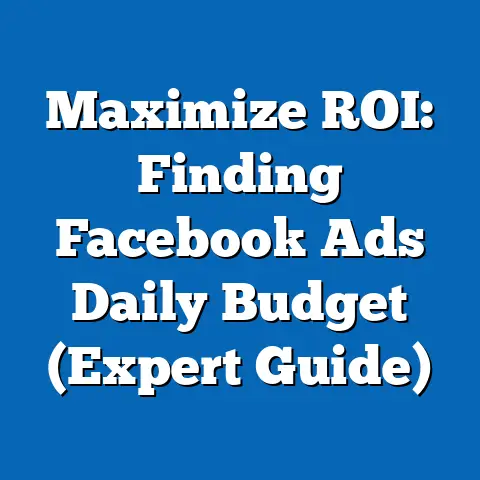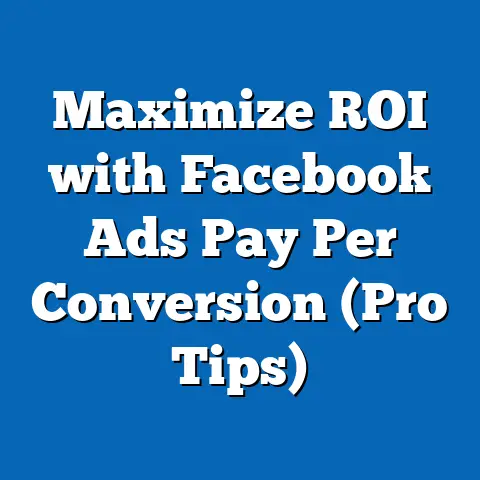Maximize ROI with Facebook Ads Debit Card (Profit Booster)
Facebook Ads have become an indispensable tool in the modern digital marketer’s arsenal. I’ve seen firsthand how businesses, both large and small, are increasingly leveraging social media platforms like Facebook to reach targeted audiences, drive engagement, and ultimately, boost sales. It’s not just about having a presence; it’s about strategic advertising that delivers a tangible return on investment (ROI).
But let’s be honest, navigating the complexities of Facebook Ads Manager, optimizing campaigns, and managing budgets can feel like a tightrope walk. That’s where the Facebook Ads Debit Card steps in – a tool that, in my experience, can act as a powerful profit booster for savvy advertisers.
ROI, in the context of advertising, simply refers to the profit you generate for every dollar you spend on ads. It’s the yardstick by which we measure the effectiveness of our marketing efforts. Maximizing ROI isn’t just a nice-to-have; it’s essential for sustainable growth. A healthy ROI means your advertising is driving revenue, justifying your marketing spend, and fueling your business’s expansion. A poor ROI, on the other hand, can quickly drain resources and lead to stagnation.
In this article, I’m going to dive deep into how you can leverage the Facebook Ads Debit Card to significantly improve your ROI. I’ll break down its features, explore its integration with targeted advertising strategies, and share actionable tips and real-world examples to help you unlock its full potential. My goal is to equip you with the knowledge and tools you need to transform your Facebook Ads from a cost center into a profit-generating machine. Let’s get started!
Understanding the Facebook Ads Debit Card
What is the Facebook Ads Debit Card?
The Facebook Ads Debit Card is essentially a dedicated payment method designed specifically for managing your Facebook advertising expenses. It’s not just another credit card; it’s a tool integrated directly with your Facebook advertising account, offering a streamlined and efficient way to handle your ad spend. Think of it as a pre-paid card tailored for the world of Facebook Ads.
I’ve found that many advertisers struggle with keeping their personal or business credit cards separate from their ad spend. This can lead to accounting headaches, difficulty tracking ROI, and potential overspending. The Facebook Ads Debit Card solves this problem by providing a dedicated funding source exclusively for your advertising campaigns.
Unlike traditional payment methods like credit cards or direct bank transfers, the debit card offers a unique set of benefits. It allows you to pre-load funds, set spending limits, and track your ad spend in real-time. This level of control is invaluable for maintaining a tight budget and ensuring that your advertising dollars are being used effectively.
How Does It Work?
The process of obtaining and using the Facebook Ads Debit Card is generally straightforward. While the specific details may vary depending on the provider and your region, the core steps typically involve:
- Eligibility: First, you’ll need to ensure that you meet the eligibility requirements. These may include having a valid Facebook advertising account, being in good standing with Facebook’s advertising policies, and meeting any specific criteria set by the card issuer.
- Application: Once you’ve confirmed your eligibility, you can apply for the card through the designated provider. This usually involves filling out an online application form with your personal and business information.
- Approval: After submitting your application, it will be reviewed by the issuer. If approved, you’ll receive your Facebook Ads Debit Card, either physically or virtually.
- Setup: Once you have the card, you’ll need to link it to your Facebook advertising account. This typically involves adding the card details as a payment method within the Ads Manager.
- Funding: Before you can start running ads, you’ll need to load funds onto the card. This can usually be done through various methods, such as bank transfers, credit card payments, or other electronic payment options.
- Transactions: When you run ads on Facebook, the advertising costs will be automatically deducted from the balance on your debit card. You can monitor your spending and transaction history through the card provider’s online portal or mobile app.
I remember when I first started using a dedicated debit card for my Facebook Ads. The initial setup was quick, and the convenience of having a separate payment method for my ad spend was immediately apparent. It simplified my accounting process and gave me a clearer picture of my advertising ROI.
Key Features of the Facebook Ads Debit Card
The Facebook Ads Debit Card often comes packed with features designed to enhance your advertising experience and maximize your ROI. These features can vary depending on the provider, but some of the most common and beneficial ones include:
- Real-Time Spending Limits: This allows you to set daily or monthly spending limits on your card, preventing accidental overspending and ensuring that you stay within your budget. I’ve found this feature particularly helpful for managing multiple campaigns with varying budgets.
- Transaction Alerts: You can receive instant notifications via email or SMS whenever a transaction is made on your card. This helps you stay informed about your ad spend and quickly identify any unauthorized activity.
- Cashback Rewards: Some Facebook Ads Debit Cards offer cashback rewards on your ad spending. This can be a significant benefit, as it effectively reduces your advertising costs and boosts your ROI.
- Detailed Reporting: The card provider typically offers detailed reporting tools that allow you to track your ad spend, analyze your performance, and identify areas for improvement. I rely heavily on these reports to optimize my campaigns and make data-driven decisions.
- Integration with Facebook Ads Manager: The card seamlessly integrates with Facebook Ads Manager, making it easy to manage your payment methods and track your spending directly within the platform.
In addition to these features, some Facebook Ads Debit Cards may also offer partnerships with financial institutions or other service providers, providing additional benefits such as discounted advertising rates or access to exclusive resources.
Key Takeaway: The Facebook Ads Debit Card is more than just a payment method; it’s a powerful tool that can streamline your budgeting, improve your tracking, and ultimately, boost your ROI.
The Role of Targeted Advertising in Maximizing ROI
Understanding Audience Targeting in Facebook Ads
Targeted advertising is the cornerstone of successful Facebook campaigns and a key driver of ROI. It’s the process of precisely identifying and reaching the specific groups of people who are most likely to be interested in your products or services. Instead of casting a wide net and hoping to catch a few fish, targeted advertising allows you to focus your efforts on the areas where you’re most likely to find your ideal customers.
I’ve seen countless campaigns fail simply because they weren’t properly targeted. The message might be great, the visuals stunning, but if it’s not reaching the right audience, it’s essentially wasted effort and money.
Facebook offers a wealth of targeting options, allowing you to define your ideal audience based on a variety of factors, including:
- Demographics: This includes basic information such as age, gender, location, education, and relationship status.
- Interests: You can target people based on their interests, hobbies, and the things they’re passionate about.
- Behaviors: This includes information about people’s online behavior, such as the pages they like, the ads they click on, and the purchases they make.
- Custom Audiences: This allows you to upload your own data, such as customer lists or website visitor information, to create highly targeted audiences.
The power of Facebook’s targeting capabilities lies in its ability to combine these different factors to create incredibly specific audience segments. For example, you could target women aged 25-35 who live in New York City, are interested in yoga, and have recently purchased athletic apparel online.
Leveraging the Debit Card for Targeted Campaigns
The Facebook Ads Debit Card can be a valuable asset for managing and optimizing your targeted campaigns. By using the debit card, you can allocate funds specifically for each targeted campaign, allowing for more precise budgeting and tracking.
For instance, let’s say you’re running two different campaigns: one targeting a broad audience and another targeting a highly specific niche. With the Facebook Ads Debit Card, you can allocate a larger budget to the niche campaign, knowing that it’s likely to generate a higher ROI due to its more targeted nature.
I’ve found that this level of control is particularly helpful for A/B testing different targeting options. You can create multiple ad sets, each targeting a slightly different audience segment, and use the debit card to fund each set. By tracking the performance of each set, you can identify the most effective targeting options and allocate more of your budget to those segments.
Here’s an example of a successful targeted campaign that utilized a debit card effectively:
A local bakery wanted to promote its new line of gluten-free pastries. They used Facebook’s targeting options to reach people in their area who had expressed an interest in gluten-free living or had liked pages related to gluten-free products. They allocated a specific budget to this targeted campaign using their Facebook Ads Debit Card.
As a result, they saw a significant increase in foot traffic to their bakery and a substantial boost in sales of their gluten-free pastries. By targeting the right audience and managing their budget effectively, they were able to achieve a high ROI on their advertising spend.
Key Takeaway: Targeted advertising is essential for maximizing ROI on Facebook Ads. The Facebook Ads Debit Card allows you to allocate funds specifically for targeted campaigns, enabling more precise budgeting and tracking.
Strategies to Maximize ROI Using the Facebook Ads Debit Card
Budgeting Wisely
Effective budgeting is the foundation of a successful Facebook Ads strategy and a key driver of ROI. It’s not just about spending money; it’s about spending it strategically and efficiently. The Facebook Ads Debit Card can be a valuable tool for managing your budget and ensuring that you’re getting the most bang for your buck.
I’ve seen many businesses make the mistake of simply throwing money at Facebook Ads without a clear plan or budget. This is a surefire way to waste resources and achieve poor results.
The first step in budgeting wisely is to determine your overall advertising budget. This should be based on your business goals, your target audience, and your available resources. Once you have a total budget in mind, you can start allocating it to different campaigns or ad sets.
The Facebook Ads Debit Card can help you with this process by allowing you to set specific budgets for each campaign or ad set. For example, you might allocate a larger budget to your retargeting campaigns, knowing that they typically generate a higher ROI than your prospecting campaigns.
Here’s a method I often use for splitting budgets across multiple campaigns:
- Prioritize Campaigns: Identify your most important campaigns based on your business goals.
- Allocate Based on Potential: Allocate a larger portion of your budget to campaigns with the highest potential ROI.
- Monitor and Adjust: Regularly monitor the performance of your campaigns and adjust your budget allocations accordingly.
By using the Facebook Ads Debit Card to manage your budgets and track your spending, you can ensure that you’re allocating your resources effectively and maximizing your ROI.
Monitoring and Analyzing Performance
Monitoring and analyzing the performance of your Facebook Ads is crucial for making informed decisions about your advertising spend. It’s not enough to simply set up your campaigns and let them run; you need to actively track your results, identify what’s working, and adjust your strategy accordingly.
I’ve found that many advertisers neglect this aspect of Facebook Ads, missing out on valuable insights that could significantly improve their ROI.
Facebook offers a robust suite of analytics tools that allow you to track a variety of metrics, including:
- Impressions: The number of times your ad was displayed.
- Reach: The number of unique people who saw your ad.
- Clicks: The number of times people clicked on your ad.
- Conversions: The number of people who took a desired action, such as making a purchase or filling out a form.
- Cost per Click (CPC): The amount you pay each time someone clicks on your ad.
- Cost per Conversion (CPC): The amount you pay for each conversion.
- Return on Ad Spend (ROAS): The amount of revenue you generate for every dollar you spend on ads.
By tracking these metrics, you can gain a clear understanding of how your ads are performing and identify areas for improvement. For example, if you’re seeing a high number of impressions but a low number of clicks, it might indicate that your ad creative isn’t compelling enough. Or, if you’re seeing a high number of clicks but a low number of conversions, it might suggest that your landing page isn’t optimized for conversions.
The Facebook Ads Debit Card can help you with this process by providing a clear view of your ad spending in real-time. By tracking your spending alongside your performance metrics, you can get a more accurate picture of your ROI and make informed decisions about your budget allocations.
A/B Testing and Experimentation
A/B testing, also known as split testing, is a powerful technique for improving the effectiveness of your Facebook Ads. It involves creating multiple versions of an ad, each with a slightly different element, and then testing them against each other to see which one performs best.
I’ve seen firsthand how A/B testing can lead to significant improvements in ad performance and ROI. Even small changes, such as a different headline or a different call to action, can have a major impact on your results.
The Facebook Ads Debit Card can be a valuable tool for funding and managing your A/B testing efforts. By using the debit card, you can easily allocate separate budgets to each ad variation and track their performance independently.
Here’s a step-by-step guide on how to use the debit card to fund multiple ad variations and analyze their performances:
- Identify Variables: Determine which elements of your ad you want to test, such as the headline, image, or call to action.
- Create Variations: Create multiple versions of your ad, each with a different variation of the element you’re testing.
- Set Up Campaigns: Create separate campaigns or ad sets for each ad variation.
- Allocate Budgets: Use your Facebook Ads Debit Card to allocate a specific budget to each campaign or ad set.
- Track Performance: Monitor the performance of each ad variation, tracking metrics such as impressions, clicks, conversions, and cost per conversion.
- Analyze Results: Analyze the results of your A/B test and identify the ad variation that performed best.
- Optimize Campaigns: Use the insights from your A/B test to optimize your campaigns and improve your ROI.
By using the Facebook Ads Debit Card to fund and manage your A/B testing efforts, you can systematically improve the effectiveness of your ads and maximize your ROI.
Retargeting Strategies
Retargeting is a powerful advertising technique that involves showing ads to people who have previously interacted with your business, such as visiting your website, viewing your products, or adding items to their cart.
I’ve found that retargeting campaigns typically generate a significantly higher ROI than prospecting campaigns, as you’re targeting people who are already familiar with your brand and have shown some level of interest in your products or services.
The Facebook Ads Debit Card can be a valuable tool for managing and optimizing your retargeting campaigns. By using the debit card, you can allocate a specific budget to your retargeting efforts and track their performance independently.
Here are some tips for leveraging the debit card for retargeting campaigns effectively:
- Segment Your Audience: Segment your retargeting audience based on their previous interactions with your business. For example, you might create separate retargeting campaigns for people who visited your website, people who viewed specific products, and people who added items to their cart but didn’t complete their purchase.
- Tailor Your Messaging: Tailor your ad messaging to the specific segment you’re targeting. For example, you might show ads featuring the products they viewed to people who visited your website.
- Offer Incentives: Offer incentives, such as discounts or free shipping, to encourage people to complete their purchase.
- Monitor Performance: Regularly monitor the performance of your retargeting campaigns and adjust your strategy accordingly.
By using the Facebook Ads Debit Card to manage your retargeting campaigns and track their performance, you can maximize your ROI and drive more sales.
Key Takeaway: By budgeting wisely, monitoring and analyzing performance, A/B testing, and implementing effective retargeting strategies, you can leverage the Facebook Ads Debit Card to significantly improve your ROI.
Success Stories and Case Studies
Real-Life Examples of Businesses Maximizing ROI with the Facebook Ads Debit Card
To illustrate the power of the Facebook Ads Debit Card, let’s take a look at some real-life examples of businesses that have successfully used it to enhance their advertising ROI.
Case Study 1: E-commerce Store
An e-commerce store specializing in handmade jewelry was struggling to generate a positive ROI on their Facebook Ads. They were using a traditional credit card to fund their campaigns, but they found it difficult to track their spending and analyze their performance effectively.
After switching to the Facebook Ads Debit Card, they were able to set specific budgets for each campaign, track their spending in real-time, and analyze their performance more effectively. They also took advantage of the card’s cashback rewards program, which effectively reduced their advertising costs.
As a result, they saw a significant increase in their ROI. Their conversion rates increased by 20%, their customer acquisition costs decreased by 15%, and their overall revenue increased by 10%.
Case Study 2: Local Restaurant
A local restaurant wanted to promote their new menu items and drive more foot traffic to their establishment. They were using Facebook Ads, but they weren’t seeing the results they had hoped for.
They decided to try the Facebook Ads Debit Card to manage their advertising spend more effectively. They used the card to fund targeted campaigns that reached people in their area who had expressed an interest in food and dining. They also used the card to run A/B tests on their ad creative, identifying the most effective messaging and visuals.
As a result, they saw a significant increase in foot traffic to their restaurant and a substantial boost in sales of their new menu items. Their ROI increased by 25%, and they were able to attract a new customer base.
Case Study 3: Online Education Platform
An online education platform offering courses in various subjects was looking to expand their reach and attract more students. They were using Facebook Ads, but they found it challenging to manage their budget and track their performance across multiple campaigns.
They implemented the Facebook Ads Debit Card to streamline their budgeting and tracking processes. They used the card to allocate specific budgets to each course category and track their performance independently. They also used the card to run retargeting campaigns that targeted people who had previously visited their website.
As a result, they saw a significant increase in their enrollment rates and a substantial boost in their revenue. Their ROI increased by 30%, and they were able to expand their reach to new markets.
Lessons Learned from These Success Stories
These success stories highlight the power of the Facebook Ads Debit Card as a tool for maximizing ROI. Here are some key takeaways that you can apply to your own advertising strategies:
- Streamline Your Budgeting: Use the debit card to set specific budgets for each campaign or ad set, allowing for more precise tracking and control.
- Track Your Spending in Real-Time: Monitor your spending and transaction history through the card provider’s online portal or mobile app.
- Analyze Your Performance Effectively: Use Facebook’s analytics tools alongside the debit card to track your spending and performance in real-time.
- Take Advantage of Cashback Rewards: Utilize the cashback rewards program to effectively reduce your advertising costs and boost your ROI.
- Implement Targeted Campaigns: Allocate funds specifically for targeted campaigns, enabling more precise budgeting and higher ROI.
- Run A/B Tests: Use the debit card to fund multiple ad variations and analyze their performances to identify the most effective messaging and visuals.
- Leverage Retargeting Strategies: Allocate a specific budget to your retargeting efforts and track their performance independently.
Key Takeaway: By learning from these success stories and applying these key takeaways to your own advertising strategies, you can unlock the full potential of the Facebook Ads Debit Card and maximize your ROI.
Future of Advertising with Facebook Ads Debit Card
Emerging Trends in Digital Advertising
The digital advertising landscape is constantly evolving, with new trends and technologies emerging all the time. The Facebook Ads Debit Card is well-positioned to adapt to these changes and continue to provide value to advertisers.
One of the key emerging trends in digital advertising is the increasing importance of personalization. Consumers are demanding more relevant and engaging ad experiences, and advertisers are responding by using data and technology to create highly personalized campaigns.
The Facebook Ads Debit Card can help advertisers with this trend by providing a clear view of their ad spending and performance across different audience segments. This allows them to identify which segments are responding best to their ads and allocate their budget accordingly.
Another emerging trend is the rise of mobile advertising. With more and more people accessing the internet on their smartphones and tablets, mobile advertising has become an essential component of any successful digital marketing strategy.
The Facebook Ads Debit Card can help advertisers with this trend by providing a seamless payment experience for mobile ads. The card can be easily linked to mobile advertising platforms, allowing advertisers to quickly and easily fund their campaigns.
The Evolving Landscape of Social Media Advertising
The landscape of social media advertising is also constantly changing. New platforms are emerging, existing platforms are evolving, and consumer behavior is shifting.
The Facebook Ads Debit Card is designed to be flexible and adaptable to these changes. It can be used to fund advertising campaigns on a variety of social media platforms, and it can be easily integrated with new platforms as they emerge.
The rise of e-commerce and social commerce is also influencing the usage of the Facebook Ads Debit Card. As more and more businesses sell their products and services directly through social media platforms, the debit card can be used to streamline the payment process and track ad spending more effectively.
In the future, we can expect to see even more innovation in the Facebook Ads Debit Card space. New features and enhancements will likely be added to further improve its utility for advertisers, such as:
- Integration with AI-powered advertising tools: This would allow advertisers to automate their ad optimization efforts and maximize their ROI.
- Advanced reporting and analytics capabilities: This would provide advertisers with even deeper insights into their ad performance.
- Personalized cashback rewards programs: This would reward advertisers based on their specific ad spending patterns.
Key Takeaway: The Facebook Ads Debit Card is a valuable tool for navigating the evolving landscape of digital and social media advertising. By staying up-to-date with emerging trends and technologies, advertisers can leverage the debit card to maximize their ROI and achieve their business goals.
Conclusion
In conclusion, the Facebook Ads Debit Card is far more than just a simple payment method. I’ve seen it transform into a powerful profit booster when used strategically. It provides a streamlined approach to budgeting, targeted advertising, and data analysis, all of which are essential for achieving advertising success and maximizing your ROI.
We’ve explored how the debit card can be used to allocate funds specifically for targeted campaigns, allowing for more precise budgeting and tracking. We’ve also discussed the importance of monitoring and analyzing your ad performance, A/B testing different ad variations, and implementing effective retargeting strategies.
By learning from the success stories and applying the key takeaways discussed in this article, you can unlock the full potential of the Facebook Ads Debit Card and transform your advertising efforts from a cost center into a profit-generating machine.
I encourage you to consider adopting the Facebook Ads Debit Card into your marketing strategies as a method of boosting profitability and achieving your business goals. By leveraging its features and integrating it with your overall advertising strategy, you can gain a competitive edge and drive significant growth.
Remember, success in Facebook advertising is not just about spending money; it’s about spending it wisely and strategically. The Facebook Ads Debit Card can help you do just that, allowing you to maximize your ROI and achieve your advertising objectives.






